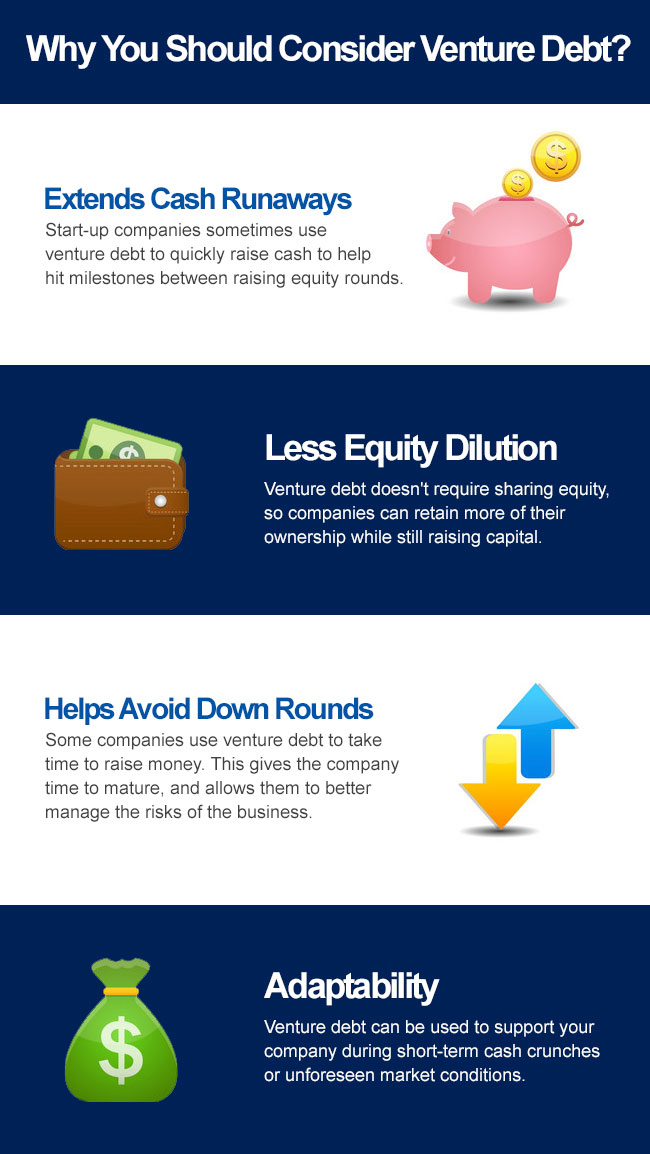Venture Debt
SWK offers structured debt financings we believe are best described as enterprise value loans. Enterprise value loans can broadly be defined as loans to companies lacking hard assets or positive cash flows and are therefore unable to qualify for traditional bank debt financing. These companies do however have substantial enterprise values capable of supporting debt financing.
Venture Debt is one example of enterprise loans. Despite taking a slightly different approach to lending, SWK has become a trusted partner in the venture debt space since 2012. There is no generally accepted definition of venture debt, but the information below summarizes the industry broadly while also discussing how SWK deviates from the norms in ways we believe enhances value for our borrower partners.
What is Venture Debt?
As the name suggests, venture debt is non-dilutive loan financing made to earlier-stage innovative companies backed by institutional equity investors. Venture loans are primarily made to companies participating in the innovation economy focused around the life sciences, healthcare, and technology/software sectors. Venture debt is typically extended to companies that lack hard assets or positive cash flows and are therefore unable to qualify for traditional bank debt financing. Venture loans can be either senior or junior secured term loans and collateralized by a company’s assets, primarily intellectual property. Credit financings to venture stage companies act as a compliment to equity investments. Venture loans provide leverage to extend the runway between equity rounds and cost-effectively minimize dilution for existing investors.
![]()
Types of Venture Debt
The venture debt market can generally be divided into two primary categories: equipment financing and growth capital. Equipment financing is used specifically for the purchase of equipment, and is secured by that equipment alone. The availability of equipment financing is tied to the actual purchase of equipment, and therefore would not be available to early-stage companies that do not utilize capital equipment in their operations. Due to the existence of hard collateral underpinning the loan, equipment financing can be less costly, but often carries a similar cost of capital to growth capital loans.
Growth capital refers to term loans that can be used for any corporate purpose and is not necessarily collateralized by specific assets in the same way as equipment finance loans. Growth capital term loans are secured by a blanket lien on a company’s assets, which may or may not include a lien on intellectual property. Some lenders may find a negative pledge on a company’s intellectual property to provide sufficient collateral protection without creating a security interest in the asset.
The vast majority of venture loans fit the growth capital definition. Whereas most venture lenders offer growth capital term loans and an increasing number have begun offering both term loans and equipment loans. There are also lenders dedicated to equipment financing that do not have the desire or expertise to extend term loans to earlier-stage companies.
US Venture Lending Market Size
Most estimates from academics and practitioners peg the size of the venture debt market at roughly 10-15% of the venture capital market. This translates into total annual venture lending volume in excess of $10B worth of new loans originated per year. Further, it is estimated that upwards of 30% of VC-backed now access venture debt.
For those companies that have accessed some amount of venture debt, it tends to account for 10-25% of the total financing the company has raised.
Who Should Consider Venture Debt?
Just because a company is early in its evolution as a business, does not mean that it will be an ideal candidate for accessing venture debt. Venture debt borrowers tend to display many or most of the following qualities:
o Have received $5mm+ in equity financing from well-funded and well-regarded institutional investors
o Are currently raising or have recently raised an equity round of financing
o Most venture loans are originated between Series A and Series D rounds of equity financing, when borrowers are still growing and not yet profitable
o High-growth companies focused on one of the following industries:
o Healthcare
o Life Sciences
o Technology
o Software/SaaS
o Green energy/sustainability
Why Consider Venture Debt?
There are a number of reasons to consider venture debt:
o Increase profitability
o Increase capital
o Business growth
o Prepare for funding rounds
o Easier to obtain
o Alternative to equity funding
o No loss of control
o Doesn’t require sponsorships

Venture Debt Providers
The venture lending industry can generally be divided into two major categories: banks & non-bank specialty finance companies or funds.
Banks are chartered and heavily regulated institutions and are therefore limited in terms of the types of lending and level of risk they are able to underwrite. Despite their lack of flexibility, banks are able to offer attractive options for borrowers for various reasons:
o Cost of capital: because banks themselves have a very low cost of capital from their deposit base and they are also able to realize value through myriad other banking services provided to their borrowers, banks are able to lend at a cost of capital that is markedly lower than what non-banks can offer
Non-bank lenders are often structured as either public or private business development companies (BDC’s) or as a fund. Owing to a more relaxed regulatory regime, non-banks are able to offer more flexible financing solutions offset by a higher cost. Benefits to working with a non-bank lender include:
o Quantum of debt: non-bank lenders tend to offer an amount of debt that can be multiples of what a bank would offer. Banks tend to offer a debt amount equivalent to 25-30% of the most recent equity round of financing.
o Flexibility in structuring: venture debt often provides flexibility in allowing drawdowns to occur over time and can provide elongated periods of interest-only payments so that a borrower can manage its debt service while preserving as much capital as possible for its operations.
Contact us here to determine how we can help your life science business grow.
